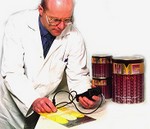These and other questions are answered in an online Knowledge Base for professional paint users and specifiers, developed by independent paintmaker HMG Paints. With a market history dating back almost 75 years and the collective experience of its paint technicians and chemists, HMG felt it appropriate to publish its most Frequently Asked Questions, to help customers solve niggling queries and check up on critical points.
The Knowledge Base is at www.hmgpaint.com and it's just a question of logging in, obtaining a password by return and clicking on the various categories. At present these cover everything from British and International Standards numbers, to spray gun set-up and surface preparation, with all the factsheets presented in easily printable Acrobat format. What's more, HMG challenges the trade to come up with other paint-related FAQ's, so the Knowledge Base can continue expanding.
Among the material available online are a theoretical paint coverage chart, an outline of the current isocyanates code of practice, an explanation of accelerated weathering tests and a factsheet on coverage rates and overcoating schedules, as well as a simple Centrigrade-Fahrenheit conversion table.
There's a fairly comprehensive document on surface preparation and product application, covering steel, aluminium, woodwork, masonry, concrete and previously-painted substrates, plus a separate sheet devoted to galvanised steel. Also featured is a guide to painting swimming pools, with a warning about proper preparation and application, and another about coating concrete floors.
HMG also offers users the resource of its R&D laboratory for identifying and counteracting difficult-to-overcoat substrates and finishes, as well as the services of its QA department for updates on current BS, ISO, EN, ASTM and other technical standards.
Answers:
- Dew point is the temperature at which condensation starts to form.
- Asthmatics should avoid processes involving isocyanates.
- Laitance or efflorescence refers to the residual salts left after concrete has dried.
- Shake the can for a minimum of 2 minutes to fully mix the contents.
- The shelf life for most paints is 12 months in cool, dry conditions.
- Amplitude is a measurement in microns of the difference between the peaks and troughs in a metal surface.
- It's best to leave a newly-painted pool around 2 weeks before filling with water.
Further enquiries to:
HMG Paints
Riverside Works
Collyhurst Road
Manchester
M40 7RU
Telephone 0161 205 7631
email sales@hmgpaint.com
